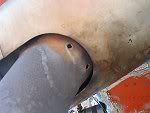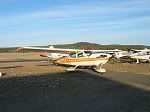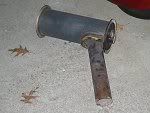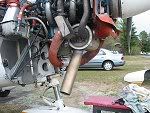Yellowbird Goes to the Vet

It's been a slow spring for Yellowbird this year, and it started with a light bulb. One fine day in March, I noticed during preflight inspection that one of her two landing lights was burned out. A quick stop at the FBO provided a replacement, but while changing the bulb, I noticed some exhaust staining on the inside of the lower cowl in the vicinity of the landing light housing. A quick look at the exhaust system showed nothing unusual, but on closer examination, I noticed two small holes at the base of the tailpipe where it joined to the muffler and right at the edge of the cabin heater shroud. They were obviously intentional, but they showed clear signs of exhaust leakage. Even with my limited knowledge of the workings of airplane exhaust systems, I couldn't imagine why there should be holes in the system, particularly inside the engine compartment and so close to the cabin heater.

A few queries to other pilots revealed that the holes were not uncommon, but no one had any ideas why they were there. My mechanic confirmed that the holes could be found on similar exhaust systems, but even he had no idea what they were there for. Everyone agreed that there should be no exhaust gasses coming from anywhere except the end of the tailpipe. I had never smelled exhaust fumes in the cabin, but I wasn't going to take any chances, so an appointment was made for Yellowbird to visit the vet. The timing was good for a few other items to be checked on, including a nagging but minor oil leak, some nicks on the propeller blades, and a loose bracket on the carburetor heat cable. At the appointed time, I dropped her off at the shop and prepared for symptoms of withdrawal.

She was in for a good two weeks, as parts were ordered and installed. Initially, she got her prop dressed, a new governor gasket, and a new carburetor heat cable, but my mechanic was as puzzled as I was about the exhaust. He couldn't see anything wrong with it at first glance, and it didn't help that I had cleaned off the exhaust staining that was the original telltale of the problem. After talking it over and examining similar exhaust systems on a few other planes in the hangar, we decided that something had to be amiss, so a new muffler was ordered as well. That decision was a good one, confirmed when the old muffler was pulled and examined more closely. From the outside, it looked whole, but a flashlight directed inside showed that the welded joint between the tailpipe and the muffler had failed at least a quarter of the way around its circumference. The two holes I had seen were not in the tailpipe itself, but in a reinforcing collar that was welded around the tailpipe/muffler joint. When the joint failed, the exhaust gasses leaked into the space between the collar and the tailpipe, and were vented out through the two holes. My mechanic guessed that the holes were there specifically to reveal any failure of the joint between the tailpipe and muffler.

With her shiny new exhaust in place, Yellowbird is once again ready for the sky. The old exhaust had lasted for more than thirty years. Let's hope the new one does also.

Addendum: Here's a view of the same joint of the new muffler, showing the reinforcing collar around the base of the tailpipe. This one only has one hole. And after less than an hour in service, it already shows some nice heat discoloration.
 It's been a slow spring for Yellowbird this year, and it started with a light bulb. One fine day in March, I noticed during preflight inspection that one of her two landing lights was burned out. A quick stop at the FBO provided a replacement, but while changing the bulb, I noticed some exhaust staining on the inside of the lower cowl in the vicinity of the landing light housing. A quick look at the exhaust system showed nothing unusual, but on closer examination, I noticed two small holes at the base of the tailpipe where it joined to the muffler and right at the edge of the cabin heater shroud. They were obviously intentional, but they showed clear signs of exhaust leakage. Even with my limited knowledge of the workings of airplane exhaust systems, I couldn't imagine why there should be holes in the system, particularly inside the engine compartment and so close to the cabin heater.
It's been a slow spring for Yellowbird this year, and it started with a light bulb. One fine day in March, I noticed during preflight inspection that one of her two landing lights was burned out. A quick stop at the FBO provided a replacement, but while changing the bulb, I noticed some exhaust staining on the inside of the lower cowl in the vicinity of the landing light housing. A quick look at the exhaust system showed nothing unusual, but on closer examination, I noticed two small holes at the base of the tailpipe where it joined to the muffler and right at the edge of the cabin heater shroud. They were obviously intentional, but they showed clear signs of exhaust leakage. Even with my limited knowledge of the workings of airplane exhaust systems, I couldn't imagine why there should be holes in the system, particularly inside the engine compartment and so close to the cabin heater. A few queries to other pilots revealed that the holes were not uncommon, but no one had any ideas why they were there. My mechanic confirmed that the holes could be found on similar exhaust systems, but even he had no idea what they were there for. Everyone agreed that there should be no exhaust gasses coming from anywhere except the end of the tailpipe. I had never smelled exhaust fumes in the cabin, but I wasn't going to take any chances, so an appointment was made for Yellowbird to visit the vet. The timing was good for a few other items to be checked on, including a nagging but minor oil leak, some nicks on the propeller blades, and a loose bracket on the carburetor heat cable. At the appointed time, I dropped her off at the shop and prepared for symptoms of withdrawal.
A few queries to other pilots revealed that the holes were not uncommon, but no one had any ideas why they were there. My mechanic confirmed that the holes could be found on similar exhaust systems, but even he had no idea what they were there for. Everyone agreed that there should be no exhaust gasses coming from anywhere except the end of the tailpipe. I had never smelled exhaust fumes in the cabin, but I wasn't going to take any chances, so an appointment was made for Yellowbird to visit the vet. The timing was good for a few other items to be checked on, including a nagging but minor oil leak, some nicks on the propeller blades, and a loose bracket on the carburetor heat cable. At the appointed time, I dropped her off at the shop and prepared for symptoms of withdrawal. She was in for a good two weeks, as parts were ordered and installed. Initially, she got her prop dressed, a new governor gasket, and a new carburetor heat cable, but my mechanic was as puzzled as I was about the exhaust. He couldn't see anything wrong with it at first glance, and it didn't help that I had cleaned off the exhaust staining that was the original telltale of the problem. After talking it over and examining similar exhaust systems on a few other planes in the hangar, we decided that something had to be amiss, so a new muffler was ordered as well. That decision was a good one, confirmed when the old muffler was pulled and examined more closely. From the outside, it looked whole, but a flashlight directed inside showed that the welded joint between the tailpipe and the muffler had failed at least a quarter of the way around its circumference. The two holes I had seen were not in the tailpipe itself, but in a reinforcing collar that was welded around the tailpipe/muffler joint. When the joint failed, the exhaust gasses leaked into the space between the collar and the tailpipe, and were vented out through the two holes. My mechanic guessed that the holes were there specifically to reveal any failure of the joint between the tailpipe and muffler.
She was in for a good two weeks, as parts were ordered and installed. Initially, she got her prop dressed, a new governor gasket, and a new carburetor heat cable, but my mechanic was as puzzled as I was about the exhaust. He couldn't see anything wrong with it at first glance, and it didn't help that I had cleaned off the exhaust staining that was the original telltale of the problem. After talking it over and examining similar exhaust systems on a few other planes in the hangar, we decided that something had to be amiss, so a new muffler was ordered as well. That decision was a good one, confirmed when the old muffler was pulled and examined more closely. From the outside, it looked whole, but a flashlight directed inside showed that the welded joint between the tailpipe and the muffler had failed at least a quarter of the way around its circumference. The two holes I had seen were not in the tailpipe itself, but in a reinforcing collar that was welded around the tailpipe/muffler joint. When the joint failed, the exhaust gasses leaked into the space between the collar and the tailpipe, and were vented out through the two holes. My mechanic guessed that the holes were there specifically to reveal any failure of the joint between the tailpipe and muffler. With her shiny new exhaust in place, Yellowbird is once again ready for the sky. The old exhaust had lasted for more than thirty years. Let's hope the new one does also.
With her shiny new exhaust in place, Yellowbird is once again ready for the sky. The old exhaust had lasted for more than thirty years. Let's hope the new one does also. Addendum: Here's a view of the same joint of the new muffler, showing the reinforcing collar around the base of the tailpipe. This one only has one hole. And after less than an hour in service, it already shows some nice heat discoloration.
Addendum: Here's a view of the same joint of the new muffler, showing the reinforcing collar around the base of the tailpipe. This one only has one hole. And after less than an hour in service, it already shows some nice heat discoloration.
Thanks!!!
At least one more (student) pilot will realize if exhaust stains are seen from the hole, time for a new muffler!
Tom